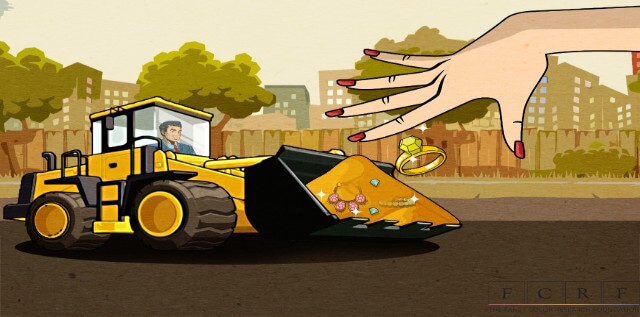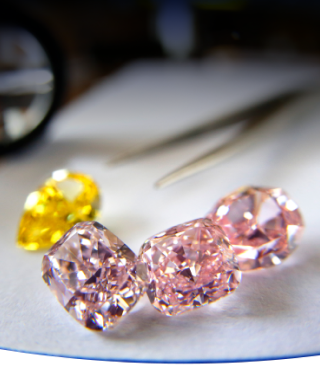Secondhand market takes the lead over mining
Over the last decade, traditional mining has failed to satisfy the market demand for exceptional Fancy Color Diamonds. At the same time, following the natural succession of generations, the pre-owned market for rare Fancy Color Diamonds seems to be taking the lead. The low volume of exotic, unearthed rough, doesn’t always land in the manufacturer’s hands.
A Bain & Company report from 2013 indicated that about 2.1 billion carats of rough diamond reserves are waiting to be unearthed, which translates to about 1 billion carats of polished diamonds. On the other hand, an FCRF proprietary research indicates that 1.6 billion carats of polished diamonds were accumulated for centuries in people’s vaults, most of them during the 20th century. It is important to remember that a significant portion of these diamonds are too small to be unmounted and will never circulate back to the trade as loose diamonds. Calculating the approximate volume of diamonds above and underground gives us a finite number of carats that we can ever trade with. Only a fraction of a percent of this number is represented by Fancy Color Diamonds. Considering the staggering number of wealthy jewelry collectors added annually worldwide, and the financial organizations buying Fancy Color to preserve wealth, there won’t be much left to trade with.
The New Trend for Mining Companies
In recent years, public mining companies have looked at new ways to increase the value of their publicly-traded shares. One of these ways had been promoting occasions when they found exceptional Fancy Color rough diamonds in the media and then trying to sell them downstream.
Several mining companies are now looking to cut and polish their Fancy Color rough diamonds in-house, and market the resulting polished diamonds through tenders to the trade. The Argyle mine has been the first to sell its polished pink diamonds through silent auctions or quarterly allocations to select companies. Since 2017, a similar business model has been carried out by the Russian mining company ALROSA. The publicly-traded Russian company was looking for new ways to brand its diamonds, so it started cutting and polishing Fancy Color rough diamonds in Moscow and then sell the polished production through diamond tenders to the trade. Other mining companies look to occasionally partner up on special Fancy Color rough diamonds with manufacturers that can polish and potentially sell them down stream.
For example: A whole production of yellow Fancy Color rough from the Ellendale mine in Australia was sold directly to a large, American jewelry brand, who cut, polished and incorporated it into its jewelry collection. The miner ‘Petra’ partnered with a group of dealers on the ownership of a large blue rough diamond (The “Blue Moon” in the polished), eventually sold through Sotheby’s. Dominion, the Canadian mining company, partnered with a US-based dealer on the ownership of a large, yellow rough diamond. The polished result was purchased by the owner of the mine. Many other examples regarding privately owned mines could be mentioned as well. This practice adopted by mining companies has created a market shortage for exceptional Fancy Color rough diamonds at the wholesale level, causing a supply chain anomaly.
Mining companies are cutting and polishing their rough diamonds in pursuit of keeping an additional slice of the profit, before offering them to the trade. In reality, they do not necessarily generate incremental profit through this practice. Many polished stones remain unsold in the miners’ safes and the ones that are sold are, according to dealers “…sold at a lower price than they would have been sold as rough diamonds”.
The “Secret Sauce”
Planning and cutting Fancy Color Diamonds requires deep understanding in areas mining companies don’t always excel in. For example, being able to have a long and intimate understanding of the high-end market and its specific diamond-demand parameters. Only after one acquires this knowledge, one can then match the make, clarity and size of a Fancy Color Diamond, in order to achieve a ‘charming stone’. Yield considerations are deprioritized when it comes to rare Fancy Color Diamonds, unlike with white diamonds.
Because mining companies lack this knowledge, “crossing” the lines to the ‘polished side’ doesn’t always generate optimal results. Evidence to that notion is the large amount of diamonds returning to the polishing wheel after they are sold in miner tenders. due to wrong planning decisions or basic polishing mistakes. Diamond dealers, who bought polished Fancy Color Diamonds directly from mining companies, will either improve the overall aesthetic of the diamond, or improve the color grade. In other cases, the poor polished outcome is irreversible and the stone cannot be “saved”. In both cases, the original potential of the rough diamond is wasted.
Platforms of the Future
For the reasons mentioned above, the circulation of Fancy Color rough diamonds is slowing down at the wholesale level. As such, the preowned polished diamond market is turning out to be an alternative arena to source rare Fancy Color Diamonds. Wealthy European, Middle-Eastern and American individuals that bought these gems during the 1970’s through the 1990’s, the ‘golden age’ of supply for large and special Fancy Color, passed on their jewelry collections to next generations over the last decade. Savvy descendants hold onto these diamonds, others are in need of cash and will sell them.
A recent example illustrates the reincarnation of these rare Fancy Color Diamonds. During 2018, a batch of rare blue diamonds, owned by a member of the Saudi royal family, was sold back to the wholesale market following the passing of the owner. In a very short time, most of this blue collection was sold downstream in jewelry creations and gained new life.
For many years, the main outlet for these goods were prominent auction houses. However, the high commission dealers leave on the table (approximately 20%), and the long time a private seller needs to wait to be paid (6 months on average), create an opportunity for new platforms that can offer better commercial terms for both sides.
Offline and online platforms emerged to facilitate the need to trade these pre-owned diamonds, especially for private individuals that are looking to profit from their jewelry in a timely manner. Most importantly, as dealers outbid each other on these platforms, they generate higher returns for these private sales, in comparison to what they would have received from traditional pawn shops on the street. Dealers, on the other hand, are exposed to a large volume of product passed through an efficient due diligence process. As of today, the volume of goods coming through these platforms is still modest but in light of the smooth mechanism they have developed, the future for these platforms seems to be promising.
To Conclude
As the years go by, the supply of Fancy Color Diamonds becomes thinner. The premier mine doesn’t produce as many exceptional blue diamonds as it used to. The Argyle mine is about to close and with it a whole ‘species’ of fine pink and red diamonds will become all but extinct. All the Alrosa Fancy Color rough diamonds no longer reach the conventional distribution channels of production. The few gems other mining companies unearth are being pushed towards partnerships and do not enter the traditional trading cycle.
Fortunately, with the energy conservation law coming into play, the infrastructure for recycling Fancy Color Diamonds begins to materialize. Most important Fancy Color Diamonds will pass from one generation to the other, a small number will eventually appear back on the market through new platforms, and some goods will gravitate from private collections and will return to the wholesale market. Diamonds that were produced before this millennium will undergo a “face-lift” on the polishing wheel and will gain a second life through new jewelry creations or wealth preservation investments. Looking at underground rough diamond deposits, we realize that the secondhand market, relatively speaking, is in fact the largest available “mine”. This new “mine” could become the only significant source for future Fancy Color trading.


